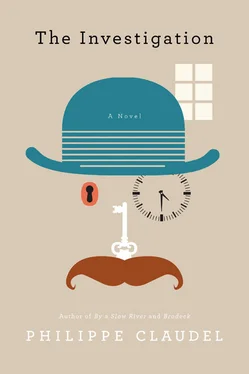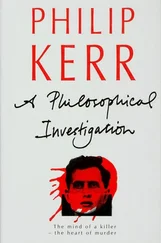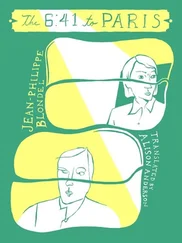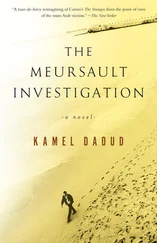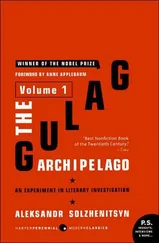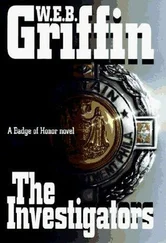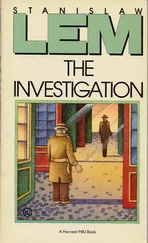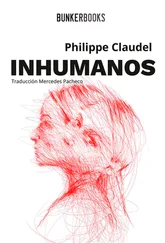The shock was extremely violent. The Investigator, with lowered head, sprinting along at maximum speed, galvanized by the tablets given him by his friend the Policeman, crashed head-on, without any last-second attempt to slow his momentum, into a wall of large cement blocks, at the foot of which the green line ended its horizontal run. He lay stretched out on the ground, released from consciousness. His body was relaxed. His cerebral activity was suspended. A swelling like a pigeon’s egg appeared on his forehead, exactly where he’d cut himself before; the wound had reopened, and a thin stream of dark blood was flowing from it.
The temperature started dropping; the sky darkened. Heavy clouds, like enormous, laden barges apparently gathering for a rendezvous, came rolling in from all sides, driven by disgruntled winds. It wasn’t long before the clouds began to bump into one another, smash into one another, rip one another open; and the first drops of icy rain fell on the Investigator, who lay there, still unconscious, and didn’t even feel them.
DURING THOSE SEVERAL HOURS, the ones he spent lying unconscious on the ground, the Investigator’s assessment of things was accurate; he was indeed dreaming. His was a real dream, that is to say, a mental construction produced when the mind is at rest, when it has no other employment, when it’s slothful and seeks none, when it’s curled up in idleness and refuses all offers of activity. The nonsense that informs the content of most real dreams is an allegorical testimony to the pernicious consequences the absence of work can have for every individual.
The Investigator passed the Enterprise’s Suicides in review. They’d all been brought into a room and lined up on the floor, one next to the other: twenty-two bodies plus one urn, containing the ashes of an employee who’d been cremated.
The Suicides still bore the signs of their final actions. Seven had ropes around their necks and protruding tongues. Six presented temples shattered by single pistol shots. One’s throat was slit; for three others, it was the veins in their wrists; two more had charred bodies, the result of their self-immolation; another’s totally cyanotic face was visible through the plastic bag he’d used to smother himself; water dripped from the bodies of two who had leaped into the river.
They were all resolutely dead, there was no doubt about it, and yet the eyes of each followed the Investigator as he moved from one to another, studying them minutely and professionally. That vision, which might well have frightened him, didn’t disturb him in the least. Similarly, he found it completely normal that the Suicides answered all the questions he put to them concerning the procedures they’d followed, their motivations, whether their successful effort had been preceded by one or more previous attempts, and the reasons why those attempts had failed. Thus far, the Investigator had somewhat neglected the urn, but when he asked who had died from gas, it was the urn that replied, and the fact that a funeral urn began to speak didn’t strike him as the least bit absurd.
“It was me, sir,” it said.
“Please call me ‘Mr. Investigator.’ ”
“Very well, Mr. Investigator.”
“So the gas, that’s you?”
“Yes.”
“One question comes to mind: Was it an accident, or was it suicide?”
“A little of both, Mr. Investigator.”
“What do you mean? That’s impossible.”
The urn seemed to hesitate before speaking again.
“I had the intention of committing suicide. My mind was made up. But I wanted to throw myself from a window, and I didn’t have time to do that. The explosion happened just as I was about to jump.”
“Were you in your apartment?”
“Yes. I’d made some coffee to give myself courage. I must have turned off the burner but forgotten to close the gas valve. It took me a long time to take the plunge, if I may use the expression. The gas escaped. I didn’t smell anything — my nose was always stopped up, owing to my numerous allergies, notably to hazel and birch pollen, acarids, and cat hair, allergies that had poisoned my existence ever since adolescence. I climbed up on the windowsill, turned the catch, and then boom. After that, nothing.”
“Boom?”
“Yes, boom, Mr. Investigator. A great boom. It’s the last memory I carry from the world of the living.”
The Investigator reflected a few moments, contemplated the urn at length, and noticed that all the other Suicides were attentively following the conversation, doubtless waiting to learn what his conclusion would be.
“Well,” the Investigator said, “that makes no difference, because you wanted to kill yourself and now you’re dead.”
“At the risk of taking up too much of your time, and with your permission, I’m not completely in agreement with you, Mr. Investigator,” the urn said hesitantly. “I’m certainly dead, but my death didn’t occur at all the way I wanted it to. And may I point out that I died several seconds before I was able to kill myself? Therefore, it wasn’t really suicide.”
“But you fell from the window all the same, didn’t you?”
Noting the urn’s apparent confusion, the Investigator told himself he’d just scored a point.
“Ye-e-es …” the urn said. “That’s undeniable, but … what actually caused my death? The fall? A cardiac arrest resulting from the shock and terror of the explosion? Or the explosion itself, which could have torn apart my lungs and all my other organs, thus leading to death almost instantaneously, or at least prior to the moment when my head struck the ground?”
“I’m waiting for you to answer those questions! What was the cause of death recorded in the autopsy report?”
“There wasn’t any autopsy. My wife had me cremated before the Police or the Enterprise had the time to demand one.”
The Investigator was stunned. All things considered, it was impossible to determine whether this particular case was a suicide or an accident. The statistical table he’d wanted to include in his Investigation made no provisions for such a scenario, and in the realm of statistics, uncertainty was intolerable. This state of affairs would discredit the seriousness of his work, and as a result, he himself would be undermined.
The urn remained silent, clearly ill at ease for having put the Investigator in such an embarrassing predicament. The Suicides looked away. Everyone could perceive the Investigator’s mounting anxiety. The moment was drawn out to such a length that it seemed it would never end.
He was delivered from it by unbearable pain.
“Don’t move! I’ll be gentle,” said a voice. A woman was bending over him. He hadn’t seen her before, yet she looked familiar to him. She had a round face, unmarked by age, and fine hair. She was wearing a long white coat. By all indications, she was either a nurse or a physician.
“What happened to me?” asked the Investigator, brutally yanked out of his dream. In every part of his skull, he felt rare, concentrated, excruciating pain.
“You ran into the wall. It happens often enough when people are distracted. Most of them get away with a bump, but I figure you must have been running like the wind if you put yourself in this state. When you were picked up, you were completely unconscious. Still, you were luckier than the Korean.”
“What Korean?”
“Two months ago. But he must have been moving even faster than you were — those people put a great deal of energy into whatever they do. That’s what gives them their economic force. The result was a Level 7 Impediment.”
“And that is …?”
“Death,” the woman replied distractedly, injecting some substance into the Investigator’s arm as she spoke.
Читать дальше
